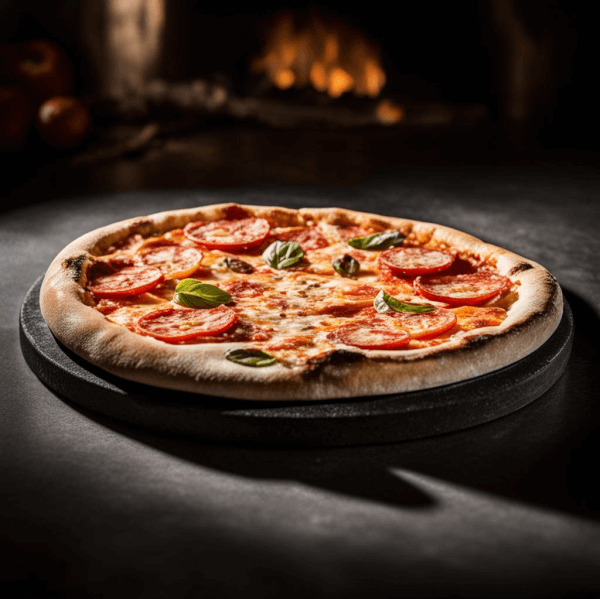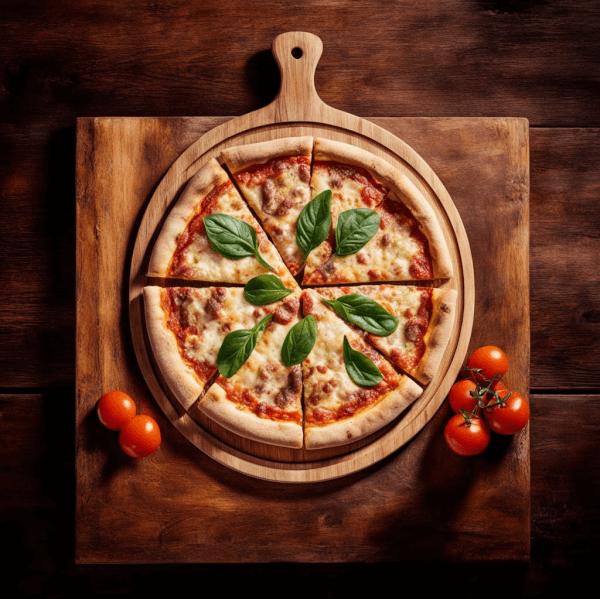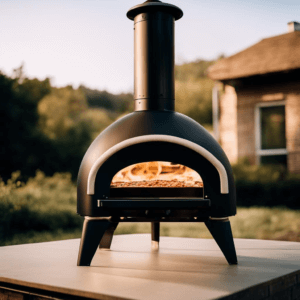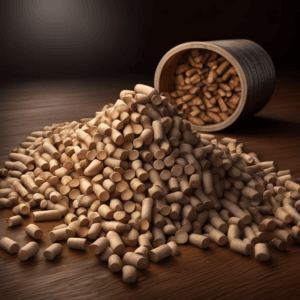Can you cut pizza on your precious pizza stone? If you’ve just pulled your perfectly golden pizza out of the oven, only to realize you don’t have a cutting board handy. You may be tempted to cut it directly on the stone, but you’ve heard horror stories about scratched, cracked, or weakened stones. What’s a pizza lover to do?
In this article, I’ll answer the burning question: can you cut pizza on a pizza stone? And more importantly, I’ll share some simple tips to help you preserve your stone and slice your pizza like a pro. Let’s dive in!
Can You Cut Pizza on a Pizza Stone?
While you can technically slice pizza on a pizza stone, it’s usually not the best idea, as you can damage the stone. You’d better transfer your pizza onto a cutting board instead.
Risks and Disadvantages:
Cutting your pizza directly on the stone might seem convenient, but it can cause some problems.
For one, you risk damaging the stone itself.
Imagine you’ve just taken a hot, fresh pizza out of the oven and onto your trusty stone.
Slicing it right there can leave scratches, and cracks, or even weaken the stone over time.
Potential Damage to Utensils:
It’s not just the stone that’s at risk.
Your cutting tools can suffer too.
Using a sharp knife or pizza cutter directly on the stone can dull their edges quicker than you’d like.
Nobody wants a pizza cutter that struggles to cut through a crust.
Safety Concerns:
And let’s not forget about safety.
If your pizza stone is still hot enough to bake another pizza, cutting directly on it can lead to an unexpected burn.
That’s something we want to avoid.
Cleaning Hassles:
Then there’s the cleanup.
Melted cheese and sauce sticking to the stone like glue can be a real pain to remove.
It’s a messy, stubborn task that can leave your once-pristine stone looking worse for wear.
Transfer your Pizza onto a Cutting Board:
So, what’s the best course of action?
I suggest taking a moment to transfer your pizza onto a cutting board before slicing.
It’s a simple step that can save you a lot of trouble in the long run.
Plus, it gives you a chance to showcase your pizza-moving skills, which is always a plus!
So, to recap, while it’s technically possible to cut pizza on a pizza stone, it’s not the smartest choice considering the potential risks and hassles involved.
By taking the extra step to transfer your pizza to a cutting board, you’ll not only protect your precious stone but also make your pizza experience smoother and more enjoyable.
Understanding Pizza Stones:
A pizza stone is essentially a thick, flat slab usually made of ceramic, cordierite, or other similar materials.
This is the best cooking surface for your pizza in the oven. Be it a special pizza oven or an ordinary kitchen unit.
Its purpose is to mimic the intense heat of a brick oven, creating that perfect crispy crust we all crave.
How a Pizza Stone Works:
When you preheat your oven with the pizza stone inside, the stone absorbs and retains heat, turning your humble kitchen appliance into a pizza powerhouse.
Once your pizza hits the hot stone, it transfers that heat directly to the crust.
This is what gives it that coveted crispy texture.
Essentially, it’s like having your own personal brick oven right at home.
Fragility of Pizza Stones:
Despite their sturdy appearance, pizza stones can be somewhat fragile.
The materials they’re made of are designed to withstand high temperatures, but they’re not indestructible.
Dropping a pizza stone or subjecting it to sudden changes in temperature can lead to cracks or breakage.
Even cutting directly on the stone with sharp utensils can cause damage over time.
Pizza Stone Preservation:
So why is it so important to keep your pizza stone in tip-top shape?
Besides the fact that it’s not exactly cheap to replace, a damaged pizza stone can affect the quality of your pizzas.
Cracks or uneven surfaces can lead to uneven cooking.
This will result in pizzas that are burnt in some spots and undercooked in others.
Plus, who wants to deal with a messy cleanup or potential safety hazards caused by damaged equipment?
Avoiding Pizza Stone Damage:
To ensure your pizza stone stays in prime condition for as long as possible, you need to handle it with care.
That means avoiding sudden temperature changes, never subjecting it to extreme temperatures (like placing a frozen pizza directly on a hot stone), and, of course, refraining from cutting directly on it.
By taking these simple precautions, you’ll not only extend the lifespan of your pizza stone but also guarantee consistently delicious homemade pizzas for years to come.
Why You Should Not Cut Pizza on a Pizza Stone:

Let’s dive into why it’s not a good idea to slice your pizza directly on the stone.
1. Preserving the Stone’s Integrity:
Pizza stones are designed to withstand high temperatures, but they have their limits.
Cutting directly on the stone can lead to scratches, chips, and cracks which can compromise its ability to evenly distribute heat.
This, in turn, can affect the overall quality of your pizzas.
And when you use a sharp knife or pizza cutter, this can create stress points that may lead to cracking, especially if the stone is still hot.
Transferring the pizza to a cutting board before slicing reduces the risk of thermal shock or other kinds of damage, and prolongs the life of your pizza stone.
2. Protecting Your Utensils:
Your favorite pizza cutter or knife may be sharp enough to handle any crust.
But they’re not designed to withstand the tough surface of a pizza stone.
Using them directly on the stone can dull their edges quickly and cause unnecessary wear and tear.
This means you’ll have to replace them sooner than expected.
3. Safety Concerns:
When you’re dealing with a piping hot pizza fresh out of the oven, the last thing you want is to accidentally burn yourself on the scorching surface of the stone.
By avoiding direct contact with the stone during the slicing process, you can reduce the risk of burns and prevent any potential accidents.
4. Simplifying Cleanup:
Cleaning up after a pizza night can be a chore, especially if you’re dealing with a stubborn mess on your pizza stone.
Cheese and sauce can quickly adhere to the surface, making it difficult to clean.
If you use a cutting board and slice your pizza there, you can avoid this mess altogether.
After all, a cutting board is much easier to clean.
It can even go in a dishwasher (depending on the material).
And you’ll save yourself time and effort in the cleanup process.
5. Maximizing Longevity:
Your pizza stone is an investment in your culinary adventures.
So you need to take good care of it.
If you avoid unnecessary wear and tear, you can make it last for years to come.
Cutting directly on the stone may seem convenient, but it can lead to costly damage over time.
By taking the extra step to transfer your pizza to a cutting board, you’re not just protecting your stone.
You’re making sure that this expensive tool lasts for many more years.
6. Even Cooking:
When you cut pizza directly on the stone, you risk creating uneven surfaces or even small divots.
These irregularities can lead to uneven cooking, with some parts of the pizza being overcooked while others remain undercooked.
7. Avoiding Flavor Transfer:
Pizza stones are porous.
This means they can absorb flavors and odors from the food cooked on them.
Cutting directly on the stone can transfer the strong topping and sauce flavors to the surface, affecting the taste of future pizzas.
When you use a cutting board instead, you can prevent flavor transfer and ensure that each pizza has a perfect taste.
10. Enhancing Presentation:
Let’s not forget about the presentation!
Slicing pizza directly on the stone can result in messy cuts and uneven slices.
This will detract from the visual appeal of your culinary masterpiece.
And if you use a cutting board, you can create clean, uniform pieces that are as pleasing to the eye as they are to the palate.
Cut Pizza on a Cutting Board Instead

Let’s talk about why it’s a smart move to transfer your freshly baked pizza onto a cutting board before you start slicing it.
1. Stability and Control:
When you’re slicing pizza, stability is key.
A cutting board offers a flat, steady surface, making it much easier to control your slicing motions.
Unlike a pizza stone, which can be uneven and slippery, a cutting board keeps your pizza steady as you cut.
And this reduces the risk of any accidental slips or wonky cuts.
2. Protection for Your Pizza Stone:
Again, your pizza stone needs some TLC.
Cutting directly on the stone can cause scratches, chips, or even cracks, which can shorten its lifespan.
By using a cutting board, you’re giving your pizza stone a break and ensuring it stays in top-notch condition for future pizza-baking adventures.
3. Versatility:
Cutting boards come in all shapes, sizes, and materials, so you can pick one that suits your style and needs.
Wood cutting boards add a rustic touch and are gentle on knife edges.
Plastic cutting boards are lightweight and easy to clean.
Bamboo cutting boards are eco-friendly and resistant to moisture.
With so many options, there’s bound to be a cutting board that fits your preferences.
4. Ease of Cleaning:
Cleaning up after pizza night is never the most fun task.
But using a cutting board can make it a whole lot easier.
Unlike a pizza stone, which can be a pain to scrub and can’t be washed with soap, cutting boards are designed for easy cleaning.
Just give it a rinse with soap and water, and you’re good to go.
Some cutting boards are even dishwasher-safe, saving you even more time and effort.
5. Presentation:
We eat with our eyes first, right?
Transferring your pizza onto a cutting board adds a touch of elegance to your culinary creation.
A beautifully plated pizza on a stylish cutting board is sure to impress your guests and take your pizza night to the next level.
Plus, with clean, uniform slices, your pizza will look as good as it tastes.
6. Practicality:
At the end of the day, using a cutting board for slicing pizza just makes sense.
It’s a simple and effective way to ensure your pizza is sliced evenly and neatly, with minimal mess and fuss.
It makes the slicing process smooth and seamless.
What Cutting Board is Best for Pizza?
When you’re ready to slice up your freshly baked pizza, you’ll want a cutting board that can handle the job with ease.
Here are a few options to consider:
1. Wooden Cutting Board:
Wooden cutting boards are a timeless choice for slicing pizza.
They offer a sturdy surface that won’t slide around as you cut, providing stability for precise slicing.
Plus, wood is gentle on knife edges, helping to keep your blades sharp for longer.
Bonus: wood naturally fights off bacteria.
So it’s a hygienic option for food prep.
2. Plastic Cutting Board:
Plastic cutting boards are lightweight, affordable, and come in a range of colors and styles to suit your kitchen decor.
They’re easy to clean and maintain.
So they are a practical choice for everyday use.
Look for a thick, sturdy plastic cutting board that can withstand the pressure of slicing through thick pizza crust without warping or bending.
3. Bamboo Cutting Board:
Bamboo cutting boards are not only eco-friendly but also incredibly durable.
They’re resistant to moisture, which means they’re less likely to warp or crack over time.
Plus, bamboo has a beautiful natural grain that adds a stylish touch to your kitchen setup.
These boards are a great choice if you’re looking for both style and functionality.
4. Pizza Peel:
If you’re dealing with an extra-large pizza that won’t fit on a standard cutting board, consider using a pizza peel instead.
While not your typical cutting board, pizza peels can double as a serving platter for your pizza.
Made of wood or metal, they offer a spacious surface area that can accommodate even the largest pies.
Simply transfer your pizza from the oven to the peel, then use it as a cutting surface at the table.
Just keep in mind that using a pizza cutter directly on the peel may cause damage, so proceed with caution.
Plus, the long handle may be inconvenient and make it unsteady when you’re cutting.
Choose a board that you feel comfortable using and that complements your pizza-making routine.
How to transfer a pizza from a pizza stone to a cutting board

Here’s a detailed guide on how to transfer a finished pizza from a pizza stone to a cutting board:
Step 1: Prepare Your Workspace
Before you even think about removing the pizza from the oven, make sure your cutting board is ready to go.
You’ll want it nearby and easily accessible, so you can smoothly transition from oven to board without any hiccups.
Step 2: Use Oven Mitts
Safety first! Protect your hands from the heat of the oven and the scorching hot pizza stone by slipping on a trusty pair of oven mitts.
No burnt fingers on pizza night!
Step 3: Remove the Pizza from the Oven
Now it’s time to carefully open the oven door and get that pizza out of there.
Use a pizza peel or spatula to gently lift the pizza off the hot pizza stone.
Metal peels are best for already-cooked pizzas.
They are thin and can slide under your pizza easily.
Slide the peel underneath the pizza, making sure to support the entire circumference to avoid any mishaps.
Step 4: Transfer to the Cutting Board
When the pizza sits safely on the peel, it’s time to make the move to the cutting board.
Gently slide the pizza from the peel onto the waiting cutting board.
If you’re worried about any toppings sliding off, you can use a gentle rocking motion to help you with smooth transfer.
Step 5: Position the Pizza
Now that the pizza is on the cutting board, take a moment to center it and make sure it’s evenly positioned for slicing.
Adjust its placement if needed and check whether it’s stable enough for slicing.
Step 6: Prepare for Slicing
Grab your preferred slicing tool: a pizza cutter, sharp knife, or maybe even some kitchen shears.
Make sure your tool of choice is sharp and ready to go for clean, smooth cuts.
Step 7: Slice and Serve
With steady hands and a steady tool, start slicing your pizza into those perfect, mouthwatering portions.
Begin from one edge and work your way across, applying even pressure to cut each slice just right.
Once sliced, transfer the pieces to plates or a serving platter and get ready to indulge in some homemade pizza goodness.
Step 8: Cleaning Up
After all the pizza has been devoured (or at least most of it), don’t forget to clean up.
Take care of both the pizza stone and the cutting board according to their respective care instructions.
So they are in tip-top shape for your next pizza night extravaganza.
How do I clean a pizza stone?
Cleaning a pizza stone is relatively simple.
Once it has cooled down completely, gently scrape off any stuck-on food with a soft brush or scraper.
Avoid using soap or water, as the stone can absorb these and affect the taste of your next pizza.
You can only wipe it with a damp clean cloth.
After that, let the stone air dry completely before using it again.
Can I use any cutting board to cut pizza?
Yes, you can use any cutting board to cut pizza, but some materials are better than others.
Wood, plastic, and bamboo cutting boards are all good options.
But wood is my personal favorite for its gentle treatment of knife edges and natural antibacterial properties.
How do I prevent my pizza stone from cracking?
Avoid subjecting it to sudden temperature changes.
Always preheat the stone with the oven and allow it to cool down gradually afterward.
Plus, avoid placing frozen pizzas or cold ingredients directly onto a hot stone.
This can cause thermal shock and lead to cracking.
Can I use a pizza peel as a cutting board?
While a pizza peel is not designed for cutting, you can use it as a makeshift cutting board.
Just be careful not to damage the peel with your cutting tool, as it may scratch or dent the surface.
It’s best to use a dedicated cutting board for slicing pizza.
Can I use a glass cutting board to cut pizza?
While glass cutting boards are durable and easy to clean, they can be harsh on knife edges and may cause them to dull more quickly.
Plus, glass cutting boards are prone to shattering or chipping if not handled carefully. And you don’t want tiny bits of glass in your food.
So it’s safer to opt for a wood, plastic, or bamboo cutting board instead.
What’s the best way to store a pizza stone?
To prolong the life of your pizza stone, store it in a cool, dry place when not in use.
Avoid keeping it in areas with high humidity or temperature fluctuations, as this can cause the stone to crack or become brittle over time.
Can I use a cutting board to transfer a pizza into the oven?
It’s not the most practical option.
Cutting boards are typically larger or smaller and less heat-resistant than pizza peels, making them more prone to warping or burning in the oven.
Plus, they don’t have a long handle. So you’ll need to come too near to a scorching hot oven.
It’s always best to use a pizza peel for transferring pizzas into the oven.
How do I prevent my cutting board from slipping while cutting pizza?
Place a damp kitchen towel or a nonslip mat underneath the board.
This will provide extra traction and stability.
So the board will stay in place as you cut.
How do I remove stuck-on cheese from my cutting board?
If cheese or other toppings become stuck to your cutting board, try scraping them off with a spatula or the back of a knife.
For stubborn residue, sprinkle some coarse salt or baking soda onto the board and scrub gently with a sponge or brush.
Then rinse with warm water and dry thoroughly.
Final thoughts
While it may seem convenient to cut your pizza directly on the pizza stone, it is not recommended as it can damage the stone and affect its performance in the future.
It’s best to transfer your pizza to a cutting board before slicing it.
This will ensure that your pizza stone remains in good condition for many more delicious pizzas to come.











